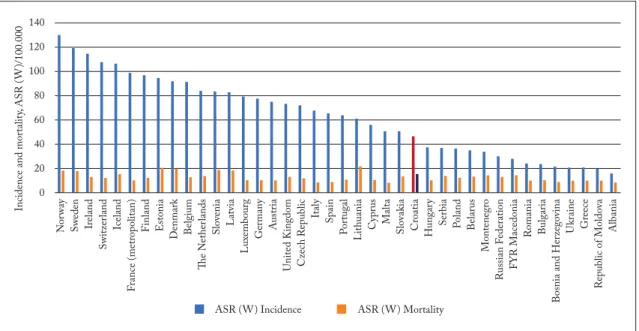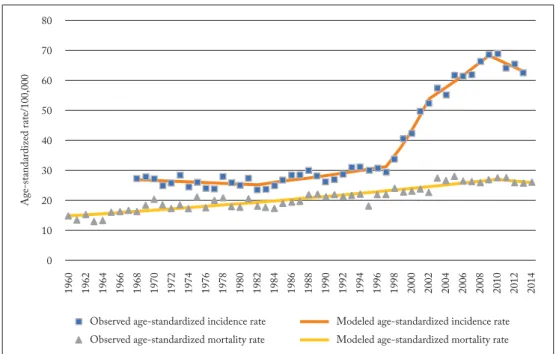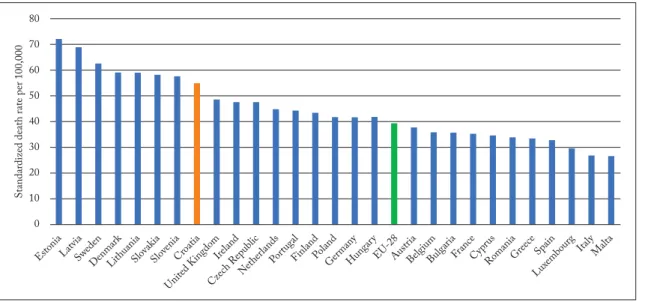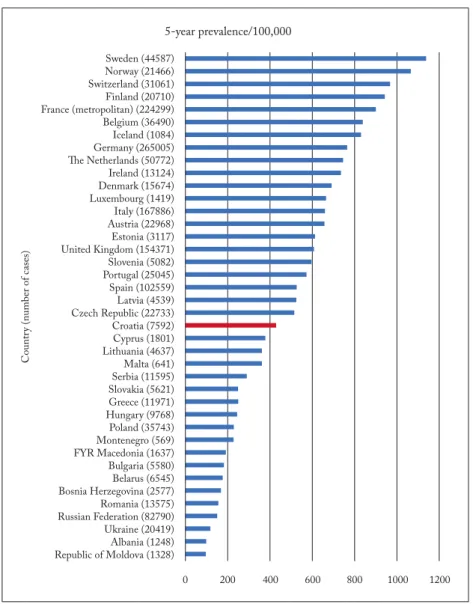Acta Clin Croat (Suppl. 1) 2018; 57:27-34 Professional Paper
doi: 10.20471/acc.2018.57.s1.03
EPIDEMIOLOGY OF PROSTATE CANCER IN CROATIA
– SITUATION AND PERSPECTIVES
Ante Reljić1,2, Petra Čukelj3, Igor Tomašković1,2,5, Boris Ružić1,2 and Mario Šekerija3,4 1Department of Urology, Sestre Milosrdnice University Hospital Center, Zagreb;
2National Referral Centre for Prostate Tumours of the Ministry of Health of the Republic of Croatia; 3Croatian National Cancer Registry, Croatian Institute of Public Health, Zagreb;
4Andrija Štampar School of Public Health, University of Zagreb, School of Medicine; 5Faculty of Medicine, Josip Juraj Strossmayer University, Osijek, Croatia
SUMMARY – Prostate cancer represents a signifi cant public health burden in Croatia, as well as in other developed countries. Th e aim of this paper was to present the current epidemiological situation in Croatia in comparison to other similar countries, using basic indicators such as incidence, mortality, prevalence and survival, and to discuss future possibilities in this fi eld. Th e incidence of prostate cancer in Croatia has been rapidly increasing since the mid-nineties; recent data indicates that the trend is levelling off . Mortality data show constant increase since the 1960s, but mortality trends seem to be stabilizing in the recent period; however, Croatia is still in the top ten countries regarding prostate cancer mortality in Europe. Five-year prevalence in 2012 was estimated at 7,592 cases (426.7/100,000), ranking Croatia in the middle of European countries in the GLOBOCAN 2012 database. According to the CONCORD-2 study, fi ve-year net survival in Croatia in the 2005-2009 period was 75.1%, which is lower than in similar European countries. Th e epidemiological pattern of prostate cancer in Croatia indicates a relatively low incidence, with signifi cant room for improvement in mortality and survival data. Given the recent discussions regarding prostate cancer screening modalities, a debate is warranted and should be encouraged regarding the role of PSA testing in Croatia.
Key words: Prostate cancer; Croatia; Incidence; Mortality; Survival; PSA testing
Correspondence to: Prim.dr.sc. Ante Reljić, Department of Uro logy, Sestre Milosrdnice University Hospital Center, Zagreb
E-mail: ante.reljic@kbcsm.hr
Received February 1, 2018, accepted May 1, 2018
Introduction
Prostate cancer is the second most common cancer in men worldwide and the fi fth cause of cancer death1.
Epidemiological indicators of the disease have changed immensely in the last couple of decades with the intro-duction of PSA testing and improvements in treat-ment. Th e disease poses a signifi cant health and fi nan-cial burden, espenan-cially in more developed countries, so it is important to explore epidemiological indicators and trends.
Risk factors for prostate cancer include, most im-portantly, older age, as well as heredity and ethnic
ori-gin2. A variety of other possible risk factors has been
discussed, including, but not limited to, nutrition, oc-cupational exposure and sexual behaviour. Th ere are no primary prevention programmes for prostate cancer; the role of PSA testing in population-based control of prostate cancer has been a matter of fi erce debate over the recent years3, with recent studies emphasizing the
possibility of a tailored limited screening programme in a narrow age-group and including active surveil-lance for men with low-risk tumours4.
Th e aim of this paper was to summarize the current epidemiological situation regarding prostate cancer in Croatia using available data and the implications of those data for future actions in prostate cancer control, with a focus on prostate cancer screening. Emphasis was placed on four main indicators of epidemiological situation regarding cancer in a particular country
(in-A. Reljić et al. Prostate cancer in Croatia
cidence, mortality, survival and prevalence) and we aimed to present the latest available data, the relative position of Croatia in comparison to other similar countries and trends over time (before and after the wider introduction of PSA testing in our country).
Incidence of prostate cancer
According to estimates for 2012, there were more than a million (1,094,916; ASR=30.6/100,000) newly diagnosed cases of prostate cancer worldwide, and 307,481 deaths (ASR=7.8/100,000)1. Prostate cancer
incidence shows substantial geographic diff erences, more than 25-fold variations between countries with the highest rates (such as France and Norway) and those with the lowest rates (Uzbekistan, Bangladesh, Nepal, Bhutan). Generally, more developed countries have higher incidence, and the rise in incidence rates coincides with the implementation of PSA testing in these countries. Only 30% of prostate cancer cases worldwide are diagnosed in less developed regions.
Incidence pattern in Europe also corresponds to the level of development – age-standardized incidence rates are higher in Western (ASR=85.8/100 000) and Northern Europe (ASR=85/100 000), and noticeably lower in Southern (ASR=58.6/100 000) and Central and Eastern Europe (ASR=31.3/100 000)5.
Compared to GLOBOCAN 2012 estimates for other European countries, Croatia has an intermediate incidence rate of prostate cancer5. With
age-standard-ized rate (ASR) of 46.2/100 000, it is ranked 26th of 40 European countries (Fig. 1). Th e highest ASR of 129.7/100 000 was found in Norway and the lowest of 15.8/100 000 in Albania. With regard to mortality data, Croatia is ranked eighth, with ASR of 15.0/100 000. Th e highest rate of 21.4/100 000 was found in Lithuania, and the lowest of 7.8/100 000 in Malta (Fig. 1).
Virtually all European and other developed coun-tries have experienced an increase in prostate cancer incidence6. Th e most prominent increase in the US
oc-curred in the early 1990s, reaching its peak in this pe-riod as a result of the introduction of a larger-scale PSA testing7. Similar increases are described in some
European countries; a publication by Center et al.6
dis-played that the average annual percent change in the most recent 10-year period was signifi cantly increas-ing in 80% (32 out of 40) of investigated countries, with changes such as +8.2% in Denmark, +8.1% in Ireland, +4.3% in Norway and +16.4% in Lithuania. In Croatia, prostate cancer incidence in this 10-year pe-riod (1998-2007) increased by 8.5%; however, the be-ginning of this period directly corresponds to a wider introduction of PSA testing in Croatia8.
Fig. 1. Estimates of age standardized (ASR-W) rates of incidence and mortality for prostate cancer in 2012, according to GLOBOCAN 2012 (5)
A. Reljić et al. Prostate cancer in Croatia
When investigating a longer period of time, as was done in a recent publication with incidence trends in Croatia ranging back to 19689, it is clear that until the
introduction of PSA testing the trends were increasing modestly (APC of +1.4% in 1982-1997 period, 95%CI 0.7 to 2.1), followed by a steep increase in 1997-2002 (APC +11.5%, 95% CI 7.5 to 15.7), a moderate in-crease in the 2002-2009 period (APC +3.5%, 95% CI 1.9 to 5.1) and without signifi cant change in trend in the 2009-2013 period (APC -2.0%, 95% CI -4.6 to 0.5) (Fig. 2). Th is analysis needs to be prolonged with more recent data in order to gauge the magnitude of changes in recent years and to estimate if the incidence of prostate cancer in Croatia has indeed, somewhat unexpectedly, reached its plateau.
Th e most recent available published data for prostate cancer incidence in Croatia from the Croatian National Cancer Registry10 show that there were 1708 new cases
of prostate cancer in Croatia in 2014; the crude rate was 82.7/100.000, the age-standardized rate (European Standard Population 1976) 64.8/100.000, and the cu-mulative incidence rate (0-74 years) was 5.5%.
Prostate cancer mortality
Prostate cancer mortality rates and trends in Europe also diff er according to regions, but diff erences are much
less pronounced than those in incidence. In countries that were EU members before 2004 (which is some-times used as a proxy measure for more developed coun-tries), the standardized death rate (SDR) decreased from 27.3/100,000 in 1992 to 19.1/100,000 in 2012 (11). In the same 20-year period mortality increased in countries that became EU members after 2004, from SDR=18.04/100,000 to SDR=21.3/100,000. Accord-ing to the same source, prostate cancer mortality in Croatia increased from 22.8/100,000 in 1992 to 26.6/100.000 in 201211.
Recent analysis of trends in prostate cancer mortal-ity in Croatia9 indicated that in the period from
1960-2010, prostate cancer mortality was increasing with a statistically signifi cant annual percent change of +1.2% (95%CI 1.0 to 1.4); there was a joinpoint in 2010 and the trend in 2010-2014 period was statistically not sig-nifi cant (APC -1.2%, 95% CI -5.5 to 3.4).
Th e data for 2014, available at EUROSTAT web-page12, also indicate that Croatia is among top ten EU
countries in prostate cancer mortality (Fig. 3), with the age-standardized mortality rate of 54.9/100,000 and share of all deaths in men of 3.0 in 2014. Th e share of all deaths in men that are attributable to prosta-te cancer ranged from 1.7% in Bulgaria to 5.6% in Sweden.
Fig. 2. Prostate cancer incidence (1968-2013) and mortality rate (1960-2014) trends in Croatia; adapted from (9)
A. Reljić et al. Prostate cancer in Croatia
Th e latest available mortality data for Croatia show that there were 769 deaths resulting from prostate cancer in 2016, with the crude rate of 38.2/100.000.
Prostate cancer survival
Prostate cancer survival can also be infl uenced by early detection of the disease, which can artifi cially lengthen survival time (lead-time bias). Th e amount of
PSA testing that is taking place in a country should always be taken into account when interpreting sur-vival and trends in sursur-vival.
Recent data on prostate cancer survival from two major international studies show that survival in Croatia is below the European average. For men diag-nosed between 2000 and 2007, the EUROCARE-5 study showed a 5-year relative survival of 71.2% in Croatia13, and the European average of 83.4%. the Fig. 3. Standardized mortality rates (ASR-E) for prostate cancer in EU countries,
according to EUROSTAT (12)
Fig. 4. Five-year age-standardized net survival of prostate cancer in European countries, according to CONCORD-2 study (13)
A. Reljić et al. Prostate cancer in Croatia
CONCORD-2 study14 showed a 75.1% 5-year net
survival for men diagnosed with prostate cancer in the 2005-2009 period, which is an improvement from the data for the periods 2000-2004 (67.7%) and 1995-1999 (61.4%); however, Croatia still has survi-val that is below the average of European countries (Fig. 4).
Prostate cancer prevalence
Th e increasing number of prostate cancers being detected through higher uptake of PSA screening has repercussions not only on survival, but on the
preva-lence of prostate cancer as well. Th e latest estimates from the International Agency for Research on Can-cer (GLOBOCAN 2012)5 indicate that the highest
5-year prevalence (the number/rate of persons alive that were diagnosed in the last 5 years) in Europe was observed in Sweden, Norway and Switzerland, where around 1/100 of all men were diagnosed with prostate cancer in the past 5 years (Fig. 5). Th e lowest 5-year prevalence was observed in the Republic of Moldova, Albania and the Ukraine, where around 1 in 1000 men were diagnosed with prostate cancer in the past 5 years. Croatia is ranked in the middle, with the rate of 426.7/100.000 (Figure 5).
Fig. 5. Estimates of 5-year prevalence of prostate cancer in European countries, according to (5)
A. Reljić et al. Prostate cancer in Croatia
PSA testing in Croatia and screening possibilities
While the highly cited US Preventive Services Task Force (USPSTF) recommendations in 2012 ad-vised against prostate cancer screening due to concerns that a signifi cant proportion of screening-detected cancers may be overdiagnosed and overtreated, the 2017 draft of the recommendations suggested an indi-vidualized decision-making about screening for pros-tate cancer after a discussion with a clinician for men between the ages of 55-6915. Future studies and pilot
projects in this fi eld are needed, while modelling and microsimulation studies suggest various possible ap-proaches depending on the context in which the screening could be done3,15,16.
A recent position paper3 suggested that starting a
pilot programme involving a limited age-group could be the next step in the control of prostate cancer, while future developments in active surveillance, stratifi ed screening strategies along with advances in biomarkers and risk prediction may further improve the cost-ef-fectiveness by improving the benefi ts and harms ratio. Also, the recent re-analysis of PLCO (Prostate, Lung, Colorectal, and Ovarian Cancer Screening Trial) and ERSPC (European Randomized Study of Screening for Prostate Cancer) data via mean lead times indi-cated that, contrary to previously published data, when diff erences in the settings and implementation of the trials are controlled for, both of these studies provide evidence in favour of prostate cancer mortality reduc-tion with screening17.
Other approaches, such as the so-called “basal PSA testing”, should also be taken into account. According to the works of Vickers and Lilja18,19, by adopting the
“basal PSA-testing” strategy in the late forties, we could identify the population at the highest risk of prostate cancer development in the following years. Such an approach, coupled with a less frequent use of PSA testing at older age, might be useful in the reduc-tion of PSA overutilizareduc-tion and the introducreduc-tion of more rational and effi cient principles in the fi eld of early diagnosis of high-risk prostate cancer. Th e dog-matic practice of regular annual PSA testing for every man over 50 that has been in practice in Croatia, re-gardless of recent and previous PSA values, has not met the expectations regarding improvement in the public health burden of prostate cancer.
In Croatia, PSA testing was widely introduced in the late 1990s and is currently applied as a mode of
opportunistic screening in men aged 50 and over, de-fi ned as individual case de-fi ndings initiated by the pa-tient and/or his physician. A debate involving all rele-vant stakeholders in Croatia on the benefi ts and harms of implementing/starting a possible diff erent prostate cancer screening programme should be initiated, with relevant national organisations and professional soci-eties and committees leading the way towards the im-plementation of the best possible scenario in the Croa-tian setting.
Summary
Croatia is a country with an intermediate incidence of prostate cancer (in comparison to other European countries), but high prostate cancer mortality. Increas-ing trends in incidence are expected, while there are no indications of decreasing trends in mortality which have been observed in other similar countries. Th e prevalence of prostate cancer in Croatia is average, while survival rates are below those of comparable Eu-ropean countries.
Although there are no reliable data on the uptake of PSA testing in Croatia, this combination of basic epide-miological parameters indicates that there is room for improvement regarding the overall prognosis and risks associated with prostate cancer in Croatian population. Th e combination of adopting new approaches in fi nd-ing prostate cancer earlier in patients who would benefi t most from it and following European trends in the di-agnostics and treatment of detected prostate cancer should be the way to move forward.
References
1. Ferlay J, Soerjomataram I, Dikshit R, Eser S, Mathers C, Re-belo M, et al. Cancer incidence and mortality worldwide: sources, methods and major patterns in GLOBOCAN 2012. Int J Cancer. 2015;136(5):E359-86. doi: 10.1002/ijc.29210. 2. Bostwick DG, Burke HB, Djakiew D, Euling S, Ho Sm,
Landolph J, et al. Human prostate cancer risk factors. Cancer. 2004;101(S10):2371-490. doi: 10.1002/cncr.20408.
3. Lönnberg S, Šekerija M, Malila N, Sarkeala T, Leja M, Májek O, et al. Cancer screening: policy recommendations on gover-nance, organization and evaluation of cancer screening. In: Al-breht T, Kiasuwa R, Van den Bulcke M, editors. European Guide on Quality Improvement in Comprehensive Cancer Control [Internet]. Ljubljana: National Institute of Public Health Slovenia; 2017 [accessed on 12.12.2017.] p. 39-76.
A. Reljić et al. Prostate cancer in Croatia
Available from: https://cancercontrol.eu/archived/uploads/im-ages/Guide/pdf/CanCon_Guide_FINAL_Web.pdf
4. Heijnsdijk EA, Bangma CH, Borràs JM, de Carvalho TM, Castells X, Eklund M, et al. Summary statement on screening for prostate cancer in Europe. Int J Cancer. 2018;142(4):741-6. 5. Ferlay J, Soerjomataram I, Ervik M, Dikshit R, Eser S, Mathers C, Rebelo M, Parkin DM, Forman D, Bray, F. GLOBOCAN 2012 v1.0, Cancer Incidence and Mortality Worldwide: IARC CancerBase No. 11 [Internet]. Lyon, France: International Agency for Research on Cancer; 2013. Available from: http:// globocan.iarc.fr, accessed on 22/01/2018.
doi: 10.1002/ijc.29210.
6. Center MM, Jemal A, Lortet-Tieulent J, Ward E, Ferlay J, Brawley O, et al. International variation in prostate cancer inci-dence and mortality rates. Eur Urol. 2012;61(6):1079-92. doi: 10.1016/j.eururo.2016.05.043.
7. Welch HG, Albertsen PC. Prostate cancer diagnosis and treat-ment after the introduction of prostate-specifi c antigen screen-ing: 1986–2005. J Natl Cancer Inst. 2009;101(19):1325-9. doi: 10.1093/jnci7djp278.
8. Spanjol J, Maricić A, Cicvarić T, Valencić M, Oguić R, Tadin T, et al. Epidemiology of prostate cancer in the mediterranean population of Croatia--a thirty-three year retrospective study. Coll Antropol. 2007;31(1):235-9.
9. Šekerija M, Sekulić K. Trends in prostate cancer incidence (1968-2013) and mortality (1960-2014) in Croatia: A join-point regression analysis. ENCR Scientifi c Meeting and Gen-eral Assembly 2016. Available from: http://www.encr.eu/im- ages/docs/Conference_2016/Poster_presentations/A11_Seke-rija_poster_ENCR2016.pdf, accessed on 12/12/2017. 10. Hrvatski zavod za javno zdravstvo, Registar za rak Republike
Hrvatske. Incidencija raka u Hrvatskoj 2014., Bilten 39, Za-greb, 2016.
11. WHO Regional Offi ce for Europe. “SDR, males, Malignant neoplasm of prostate”. European Health for All explorer. Web. Accessed January 22, 2018. https://gateway.euro.who.int/en/ hfa-explorer/
12. EUROSTAT, Statistics Explained. Cancer statistics - specifi c cancers. [Internet]. Available from: http://ec.europa.eu/euro-stat/statistics-explained/index.php/Cancer statistics -specifi c cancers, accessed on 21/01/2018.
13. Trama A, Foschi R, Larranaga N, Sant M, Fuentes-Raspall R, Serraino D, et al. Survival of male genital cancers (prostate, tes-tis and penis) in Europe 1999-2007: Results from the EURO-CARE-5 study. Eur J Cancer. 2015;51(15):2206-16 doi: 10.1016/j.ejca.2015.07.027.
14. Allemani C, Weir HK, Carreira H, Harewood R, Spika D, Wang XS, et al. Global surveillance of cancer survival 1995-2009: analysis of individual data for 25,676,887 patients from 279 population-based registries in 67 countries (CON-CORD-2). Lancet. 2015;385(9972):977-1010. doi: 10.1016/ SO140-6736(14)62038-9.
15. de Carvalho TM, Heijnsdijk EAM, de Koning HJ. Compara-tive eff ecCompara-tiveness of prostate cancer screening between the ages of 55 and 69 years followed by active surveillance. Cancer. 2017. doi: 10.1002/cncr.31141. [Epub ahead of print]
16. Heijnsdijk EAM, Wever EM, Auvinen A, Hugosson J, Ciatto S, Nelen V, et al. Quality-of-Life Eff ects of Prostate-Specifi c Antigen Screening. N Engl J Med. 2012;367(7):595-605. doi: 10.1056/NEJMoa1201637.
17. Tsodikov A, Gulati R, Heijnsdijk EAM, Pinsky PF, Moss SM, Qiu S, et al. Reconciling the Eff ects of Screening on Prostate Cancer Mortality in the ERSPC and PLCO Trials. Ann Intern Med. 2017;167(7):449-55. doi:10.7326/M16-2586.
18. Vickers AJ, Ulmert D, Sjoberg DD, Bennette CJ, Björk T, Gerdtsson A, et al. Strategy for detection of prostate cancer based on relation between prostate specifi c antigen at age 40-55 and long term risk of metastasis: case-control study. BMJ. 2013;346:f2023. doi:10.1136/bmj.f2023.
19. Lilja H, Cronin AM, Dahlin A, Manjer J, Nilsson PM, East-ham JA, et al. Prediction of signifi cant prostate cancer diag-nosed 20 to 30 years later with a single measure of prosta-te-specifi c antigen at or before age 50. Cancer. 2011;117(6): 1210-9. doi:10.1002/cncr.25568.
A. Reljić et al. Prostate cancer in Croatia
Sažetak
EPIDEMIOLOGIJA RAKA PROSTATE U HRVATSKOJ - STANJE I PERSPEKTIVE
A. Reljić, P. Čukelj, I. Tomašković, B. Ružić i M. Šekerija
Rak prostate predstavlja značajan javnozdravstveni problem, kako u Hrvatskoj, tako i u drugim razvijenim zemljama. Cilj ovog članka je prikazati trenutnu epidemiološku situaciju povezanu s rakom prostate u Hrvatskoj u usporedbi s drugim slič-nim zemljama korištenjem osnovnih epidemioloških indikatora kao što su incidencija, mortalitet, prevalencija i preživljenje, te razmotriti koje su daljnje mogućnosti za poboljšanje istih. Incidencija raka prostate u Hrvatskoj je u značajnom porastu od sredine 90-tih godina; posljednji dostupni podaci ukazuju da je taj trend potencijalno dosegao plato. Podaci o mortalitetu pokazuju stalan rast od 1960-ih, no iako vidimo stabilizaciju tog trenda u posljednjem periodu, Hrvatska je i dalje među prvih deset zemalja u Europi po smrtnosti od raka prostate. Procijenjeno je da je petogodišnja prevalencija u 2012. iznosila 7.592 slučaja (426.7/100.000), što Hrvatsku smješta u sredinu europskih zemalja prema bazi podataka GLOBOCAN 2012. Petogodišnje preživljenje od raka prostate, prema istraživanju CONCORD-2, iznosi 75.1%, što je niže od preživljenja u nama sličnim europskim zemljama. Epidemiološki trendovi raka prostate u Hrvatskoj pokazuju relativno nisku incidenciju, dok prema podacima o mortalitetu i preživljenju vidimo da postoji mnogo mjesta za napredak. U svjetlu nedavnih diskusija o modelu ranog otkrivanja raka prostate, potrebno je održati i poticati raspravu o ulozi PSA testiranja u Hrvatskoj.



